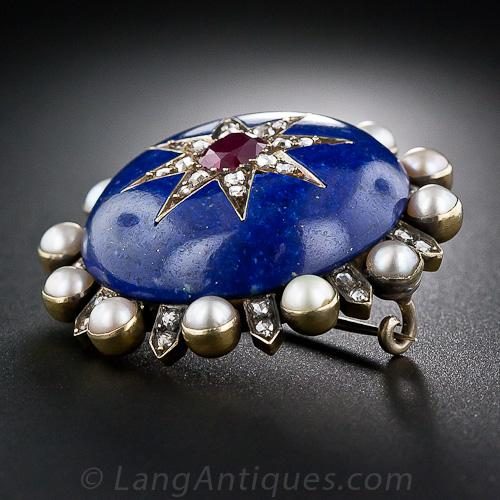
Lapis lazuli is a rock aggregate made up from – predominantly – the minerals lazurite, sodalite, nosalite and hauyne. It has a typical cobalt blue color, often with patches of pyrite (golden) and/ or calcite (white). It was this rock that was powdered to create the ultramarine pigment used by painters prior to the 19th century.1 Historically this gemstone comes from Afghanistan, a location reported by Marco Polo as early as 1271. It is thought, however, that the Romans already knew about Lapis and even the Bible2 refers to an aggregate of the wonderful blue color. Another famous locality where lapis lazuli is mined is in the Andes mountain range of Chile.
Lapis lazuli is often mimicked by a dyed jasper, but it does not show the white and golden patches. Sodalite, one of the components of lapis lazuli, is often mistaken for it, but the color is much paler. There is also a sintered synthetic spinel that imitates lapis lazuli.
Dyeing and impregnation occurs on lesser-quality gems and these can be easily removed by acetone. Leaving these stones in the sun for too long a period of time will cause the dye or impregnation to stain the environment.
Gemological Information for Lapis Lazuli
| Color: | Cobalt Blue with White or Golden Patches (Calcite and Pyrite) |
| Crystal Structure: | Rock |
| Refractive Index: | ~1.50 |
| Durability: | Durable |
| Hardness: | 5.5 |
| Family: | |
| Similar Stones: | Sodalite, Azurite, Imitation Lapis |
| Treatments: | Dyeing, Imitations |
| Country of Origin: | Afghanistan, Chile, Russia |
Lapis Lazuli Care
| Ultrasonic Cleaning: | Some Risk |
| Steam Cleaning: | Avoid |
| Warm Soapy Water: | Safe |
| Chemical Attack: | Decomposition, Effervesces, Discoloration |
| Light Sensitivity: | Stable |
| Heat Sensitivity: | Darkens or Changes Color |
Sources
- Gemmology Third Edition – Peter G. Read
- Gems, Their Sources, Descriptions and Identification 4th edition – Robert Webster, B.W. Anderson
Gems & Gemology: The Quarterly Journal of The Gemological Institute of America.
Lapis Lazuil:
- Spring 1936, The Specific Gravity of Lapis Lazuli, p. 8, 1p.
- Summer 1941, Colorado Lapis Lazuli, p. 154, 3pp.
- Fall 1954, A New Substitute for Lapis Lazuli, by Anderson, p. 88, 2pp.
- Summer 1962, A Lapis Lazuli Test, p. 315, 1p.
- Spring 1963, Translucent Lapis Lazuli (Showing Absorption Spectrum), p. 20, 1p.
- Summer 1963, Testing Stained Lapis Lazuli, p. 44, 1p.
- Fall 1965, Notes on Lapis Lazuli and its Treatment, p. 337, 2pp.
- Summer 1967, Dyed Lapis Lazuli, p. 180, 2pp.
- Spring 1968, Dyed Waxed Lapis Lazuli, p. 278, 1p.
- Summer 1970, A Beautiful Pietre Dure (Italian Inlay) Lapis Lazuli, p. 188, 1p.
- Fall 1974, Imitation Lapis Lazuli, p. 327, 4pp.
- Fall 1976, Non-Single-Crystal Synthetics (Synthetic Gilson Lapis Lazuli), by Nassau, p. 194, 5pp.